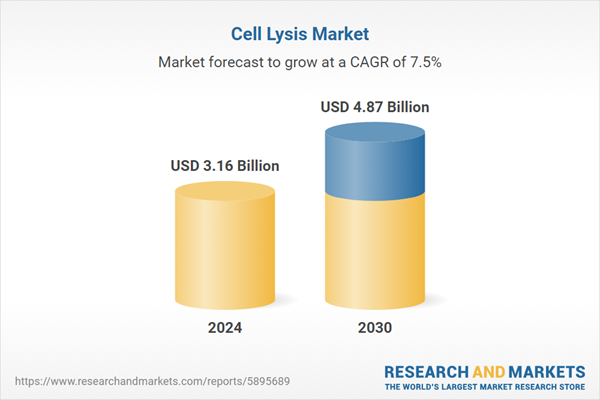Speak directly to the analyst to clarify any post sales queries you may have.
10% Free customizationThis report comes with 10% free customization, enabling you to add data that meets your specific business needs.
The biopharmaceutical industry's expansion and the shift toward targeted therapies and personalized medicine have intensified the need for efficient cell lysis techniques to extract proteins, DNA, and RNA. In parallel, advancements in genomics and proteomics are accelerating the adoption of advanced lysis technologies. As researchers focus on biomolecular isolation from various cell types, the demand for precise and scalable cell lysis methods continues to grow. This rising application spectrum reinforces cell lysis as a critical enabler in both therapeutic development and molecular diagnostics.
Key Market Drivers
Biopharmaceutical Advancements
The accelerating growth of the biopharmaceutical industry is a central force driving the global cell lysis market. With increasing focus on biologics and personalized medicine, pharmaceutical companies rely on advanced cell lysis methods to extract therapeutic proteins, DNA, and RNA.Cell lysis enhances the efficiency of drug development by facilitating rapid extraction and purification of target biomolecules. This is crucial for reducing time-to-market, especially during health crises where expedited drug development is vital. Biomanufacturing processes, including antibody and protein production, depend on optimized lysis techniques to increase yield and maintain product quality.
As the complexity of therapeutic molecules increases, advanced cell lysis tools help ensure high purity and minimize contamination, which is essential for patient safety and regulatory compliance. This growing reliance on cell lysis across the drug discovery and development lifecycle ensures sustained demand for high-performance lysis products and systems.
Key Market Challenges
High Cost of Cell Lysis Equipment and Reagents
A notable challenge in the global cell lysis market is the high cost associated with equipment and reagents. High-performance instruments, such as automated and high-pressure lysis systems, require significant capital investment, which can restrict access for smaller laboratories or institutions with limited funding.Moreover, premium-grade reagents - including enzymes, detergents, and buffers - are necessary for specific applications but can be prohibitively expensive for routine use, especially in developing countries. This limits the adoption of advanced lysis solutions and contributes to disparities in research capabilities across different regions.
Budget constraints in academic or underfunded institutions further exacerbate this issue, potentially hindering innovations in therapeutic and diagnostic research where reliable lysis techniques are essential.
Key Market Trends
Rising Demand for Biologics and Personalized Medicine
A prominent trend shaping the cell lysis market is the increasing focus on biologics and personalized therapies. The development of complex biologics - such as monoclonal antibodies, gene therapies, and vaccines - requires efficient cell lysis processes for the extraction of high-quality biomolecules.As personalized medicine gains traction, diagnostic labs are using cell lysis to isolate DNA, RNA, and proteins for genetic profiling and biomarker analysis. This enables clinicians to tailor treatments based on individual patient data, improving efficacy and minimizing side effects.
With the biopharmaceutical industry continuously innovating in molecular and precision medicine, cell lysis systems are evolving to support specific needs in both upstream and downstream processes, ensuring compatibility with high-throughput, scalable workflows.
Key Players Profiled in this Cell Lysis Market Report
- Becton, Dickinson and Company
- Bio-Rad Laboratories Inc.
- Danaher Corporation
- Eppendorf AG
- Hoffmann-La Roche Ltd
- Labfreez Instruments Group Co. Ltd
- Merck KGaA
- Qsonica LLC
- Takara Bio Inc.
- Thermo Fisher Scientific Inc.
Report Scope:
In this report, the Global Cell Lysis Market has been segmented into the following categories, in addition to the industry trends which have also been detailed below:Cell Lysis Market, by Type of Product:
- Instruments
- Reagents
Cell Lysis Market, by Type of Cells:
- Mammalian Cells
- Microbial Cells
- Plant Cells
Cell Lysis Market, by End User:
- Biotechnology or Biopharmaceutical Companies
- Research Laboratories and Academic Institutes
- Other End Users
Cell Lysis Market, by Region:
- North America
- United States
- Canada
- Mexico
- Europe
- France
- United Kingdom
- Italy
- Germany
- Spain
- Asia-Pacific
- China
- India
- Japan
- Australia
- South Korea
- South America
- Brazil
- Argentina
- Colombia
- Middle East & Africa
- South Africa
- Saudi Arabia
- UAE
- Kuwait
- Turkey
- Egypt
Competitive Landscape
Company Profiles: Detailed analysis of the major companies present in the Global Cell Lysis Market.Available Customizations:
With the given market data, the publisher offers customizations according to a company's specific needs. The following customization options are available for the report.Company Information
- Detailed analysis and profiling of additional market players (up to five).
This product will be delivered within 1-3 business days.
Table of Contents
Companies Mentioned
The leading companies profiled in this Cell Lysis market report include:- Becton, Dickinson and Company
- Bio-Rad Laboratories Inc.
- Danaher Corporation
- Eppendorf AG
- Hoffmann-La Roche Ltd
- Labfreez Instruments Group Co. Ltd
- Merck KGaA
- Qsonica LLC
- Takara Bio Inc.
- Thermo Fisher Scientific Inc.
Table Information
| Report Attribute | Details |
|---|---|
| No. of Pages | 185 |
| Published | May 2025 |
| Forecast Period | 2024 - 2030 |
| Estimated Market Value ( USD | $ 3.16 Billion |
| Forecasted Market Value ( USD | $ 4.87 Billion |
| Compound Annual Growth Rate | 7.4% |
| Regions Covered | Global |
| No. of Companies Mentioned | 11 |









